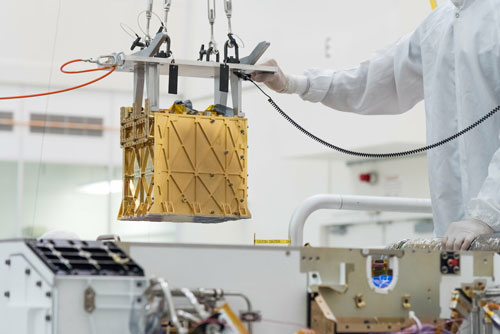New York
NASA has announced yet another first on Mars Wednesday, having literally created oxygen out of the red planet’s thin air.
According to the US space agency, the breakthrough also opens new doors for future missions where oxygen gas produced from the Martian atmosphere could be stored to help power rockets and lift astronauts off the planet.
The experimental demonstration by the toaster-sized instrument aboard the Perseverance rover – the Mars Oxygen In-Situ Resource Utilization Experiment, or MOXIE – is a critical first step at converting carbon dioxide to oxygen on Mars, according to Jim Reuter, associate administrator of Nasa’s Space Technology Mission Directorate (STMD).
“MOXIE has more work to do, but the results from this technology demonstration are full of promise as we move toward our goal of one day seeing humans on Mars,” Mr Reuter said.
Since rocket propellants need oxygen, Nasa scientists hope future explorers could produce the gas on Mars to make their trip back home.
But this would be a challenging task given that a rocket requires nearly seven metric tons of rocket fuel and 25 metric tons of oxygen to get four astronauts off the Martian surface.
“The astronauts who spend a year on the surface will maybe use one metric ton between them,” added MOXIE’s principal investigator, Michael Hecht from MIT.
As transporting the required 25 tons of oxygen from Earth to Mars would be an “arduous task,” carrying an instrument like MOXIE that can produce the gas to the Red Planet would be “far more economical and practical,” the US space agency said in a statement.
According to Nasa, MOXIE works by separating oxygen atoms from carbon dioxide (CO2) molecules in the Martian atmosphere.
The instrument breaks down CO2 – made up of one carbon atom and two oxygen atoms – producing carbon monoxide as a waste product which is emitted into the Martian atmosphere.
MOXIE has a component made of called the Solid OXide Electrolysis reactor (SOXE) which enables it to convert 30–50 per cent of the hot CO2 to carbon monoxide and oxygen gas, depending on operating conditions, Nasa scientists had noted in a previous study.
According to this study, SOXE is made of stacks of cells which split carbon dioxide gas into oxygen by applying current across its terminals in a process called electrolysis.
A single inlet stream in this device results in two outlet streams, one for the waste products, and the other for the oxygen gas.
The space agency noted in a statement that the conversion process requires high levels of heat to reach a temperature of approximately 800 degrees Celsius, and to accommodate this the instrument is made with heat-tolerant materials.
These materials include 3D-printed nickel alloy parts which regulate the temperature of gases flowing through MOXIE, and a lightweight aerogel to hold in the heat.
It also has a thin gold coating on the outside to reflect infrared heat, preventing it from radiating outwards and damaging other parts of the Perseverance rover.
In the current operation, MOXIE produced about five grams of the gas, equivalent to about 10 minutes’ worth of breathable oxygen for an astronaut, but it is designed to generate up to 10 grams of oxygen per hour, Nasa noted.
According to the US space agency, the demonstration was carried out to ensure the instrument survived the launch from Earth after its nearly seven-month long journey through space.
In future operations over the next two years, MOXIE is slated to extract oxygen at least nine more times.
Not only is it the first instrument to produce oxygen on another world, it is also a first-of-its-kind technology that will help future astronauts live off the planets they visit using elements of the world’s environment – an idea known as in-situ resource utilisation, Nasa noted.
“It’s taking regolith, the substance you find on the ground, and putting it through a processing plant, making it into a large structure, or taking carbon dioxide — the bulk of the atmosphere — and converting it into oxygen,” said Trudy Kortes, director of technology demonstrations within STMD.
“This process allows us to convert these abundant materials into useable things: propellant, breathable air, or, combined with hydrogen, water,” Ms Kortes added.
The Perseverance rover’s mission on Mars is mainly one of astrobiology – to search for signs of ancient microbial life on the Red Planet.
It will characterise the planet’s geology, its past climate, and conduct experiments to help pave the way for future human exploration of the Red Planet, as well as collect and cache Martian rock and regolith.—AP










